University Research Project: Solar Energy in Vehicles
VerifiedAdded on 2023/01/11
|9
|1584
|70
Project
AI Summary
This project proposal investigates the effective use of solar energy in vehicles, addressing the need for sustainable transportation and reduced reliance on non-renewable resources. The project aims to analyze the feasibility of solar-powered vehicles, outlining objectives such as identifying the need for solar energy, understanding effective implementation processes, and recommending strategies for its use. The research methodology involves a literature review, data collection, and analysis of existing research on solar energy and electric vehicles. The project includes a detailed timeline, milestones, and tasks, focusing on the use of photovoltaic cells to convert sunlight into electricity for vehicle propulsion. The findings are expected to contribute to the development of sustainable transportation solutions and reduce environmental impact. The project is justified by the increasing concerns about pollution and the depletion of non-renewable resources, emphasizing the potential of solar energy as a viable alternative. References include research on thermoelectric renewable energy, energy storage, electric vehicles, and smart grid integration, supporting the project's approach to mixed-method analysis and its focus on secondary data sources.
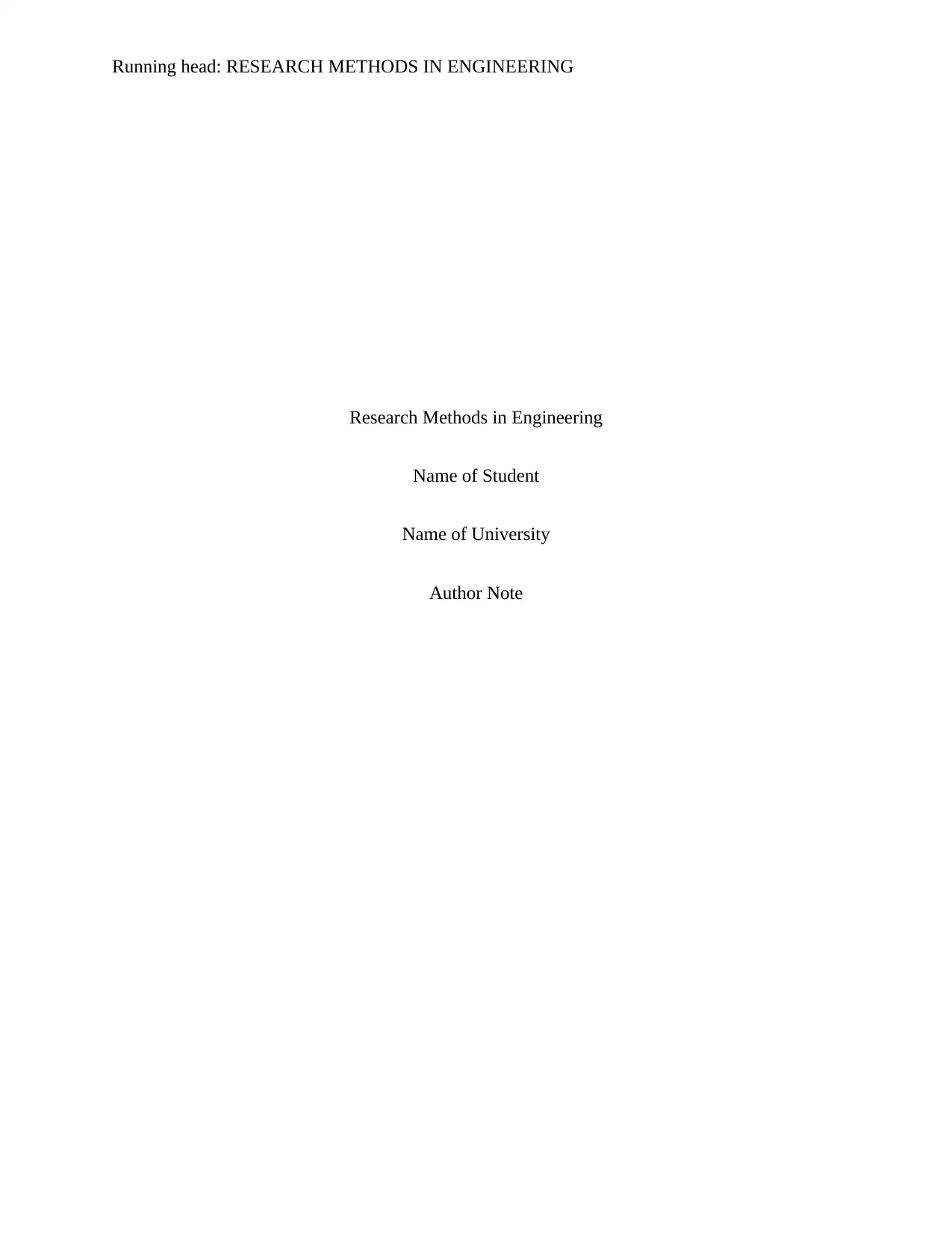
Running head: RESEARCH METHODS IN ENGINEERING
Research Methods in Engineering
Name of Student
Name of University
Author Note
Research Methods in Engineering
Name of Student
Name of University
Author Note
Paraphrase This Document
Need a fresh take? Get an instant paraphrase of this document with our AI Paraphraser
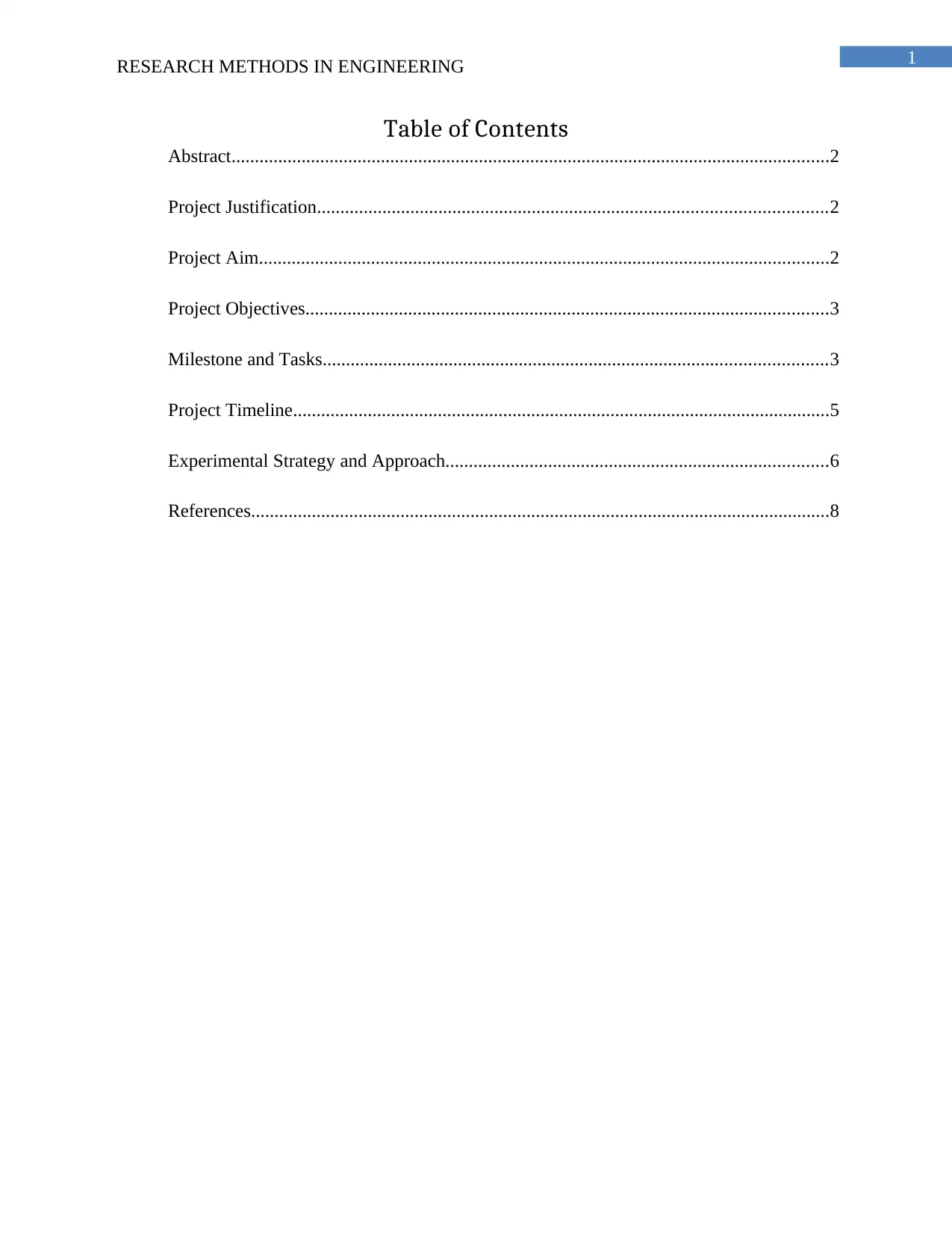
1RESEARCH METHODS IN ENGINEERING
Table of Contents
Abstract................................................................................................................................2
Project Justification.............................................................................................................2
Project Aim..........................................................................................................................2
Project Objectives................................................................................................................3
Milestone and Tasks............................................................................................................3
Project Timeline...................................................................................................................5
Experimental Strategy and Approach..................................................................................6
References............................................................................................................................8
Table of Contents
Abstract................................................................................................................................2
Project Justification.............................................................................................................2
Project Aim..........................................................................................................................2
Project Objectives................................................................................................................3
Milestone and Tasks............................................................................................................3
Project Timeline...................................................................................................................5
Experimental Strategy and Approach..................................................................................6
References............................................................................................................................8
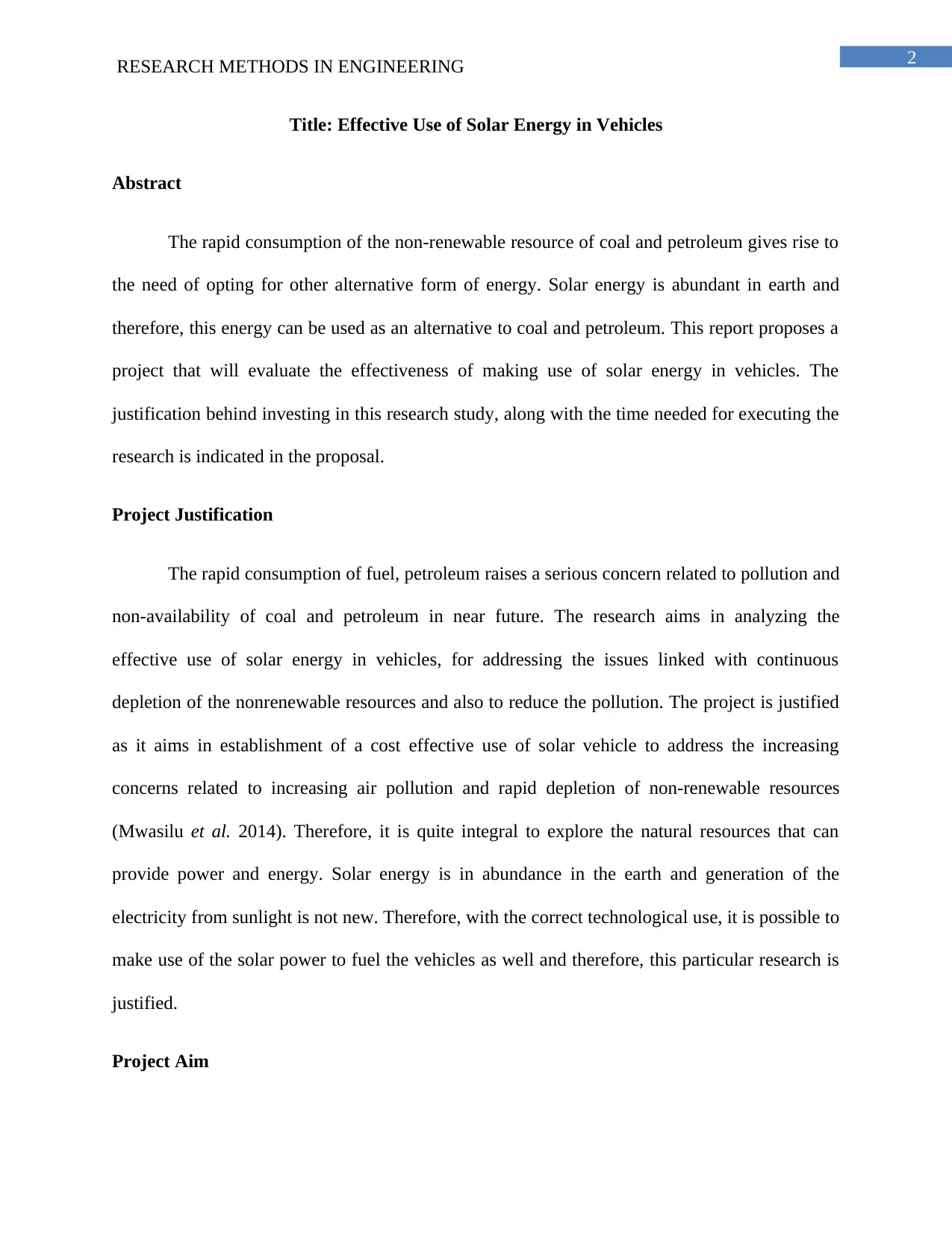
2RESEARCH METHODS IN ENGINEERING
Title: Effective Use of Solar Energy in Vehicles
Abstract
The rapid consumption of the non-renewable resource of coal and petroleum gives rise to
the need of opting for other alternative form of energy. Solar energy is abundant in earth and
therefore, this energy can be used as an alternative to coal and petroleum. This report proposes a
project that will evaluate the effectiveness of making use of solar energy in vehicles. The
justification behind investing in this research study, along with the time needed for executing the
research is indicated in the proposal.
Project Justification
The rapid consumption of fuel, petroleum raises a serious concern related to pollution and
non-availability of coal and petroleum in near future. The research aims in analyzing the
effective use of solar energy in vehicles, for addressing the issues linked with continuous
depletion of the nonrenewable resources and also to reduce the pollution. The project is justified
as it aims in establishment of a cost effective use of solar vehicle to address the increasing
concerns related to increasing air pollution and rapid depletion of non-renewable resources
(Mwasilu et al. 2014). Therefore, it is quite integral to explore the natural resources that can
provide power and energy. Solar energy is in abundance in the earth and generation of the
electricity from sunlight is not new. Therefore, with the correct technological use, it is possible to
make use of the solar power to fuel the vehicles as well and therefore, this particular research is
justified.
Project Aim
Title: Effective Use of Solar Energy in Vehicles
Abstract
The rapid consumption of the non-renewable resource of coal and petroleum gives rise to
the need of opting for other alternative form of energy. Solar energy is abundant in earth and
therefore, this energy can be used as an alternative to coal and petroleum. This report proposes a
project that will evaluate the effectiveness of making use of solar energy in vehicles. The
justification behind investing in this research study, along with the time needed for executing the
research is indicated in the proposal.
Project Justification
The rapid consumption of fuel, petroleum raises a serious concern related to pollution and
non-availability of coal and petroleum in near future. The research aims in analyzing the
effective use of solar energy in vehicles, for addressing the issues linked with continuous
depletion of the nonrenewable resources and also to reduce the pollution. The project is justified
as it aims in establishment of a cost effective use of solar vehicle to address the increasing
concerns related to increasing air pollution and rapid depletion of non-renewable resources
(Mwasilu et al. 2014). Therefore, it is quite integral to explore the natural resources that can
provide power and energy. Solar energy is in abundance in the earth and generation of the
electricity from sunlight is not new. Therefore, with the correct technological use, it is possible to
make use of the solar power to fuel the vehicles as well and therefore, this particular research is
justified.
Project Aim
⊘ This is a preview!⊘
Do you want full access?
Subscribe today to unlock all pages.

Trusted by 1+ million students worldwide
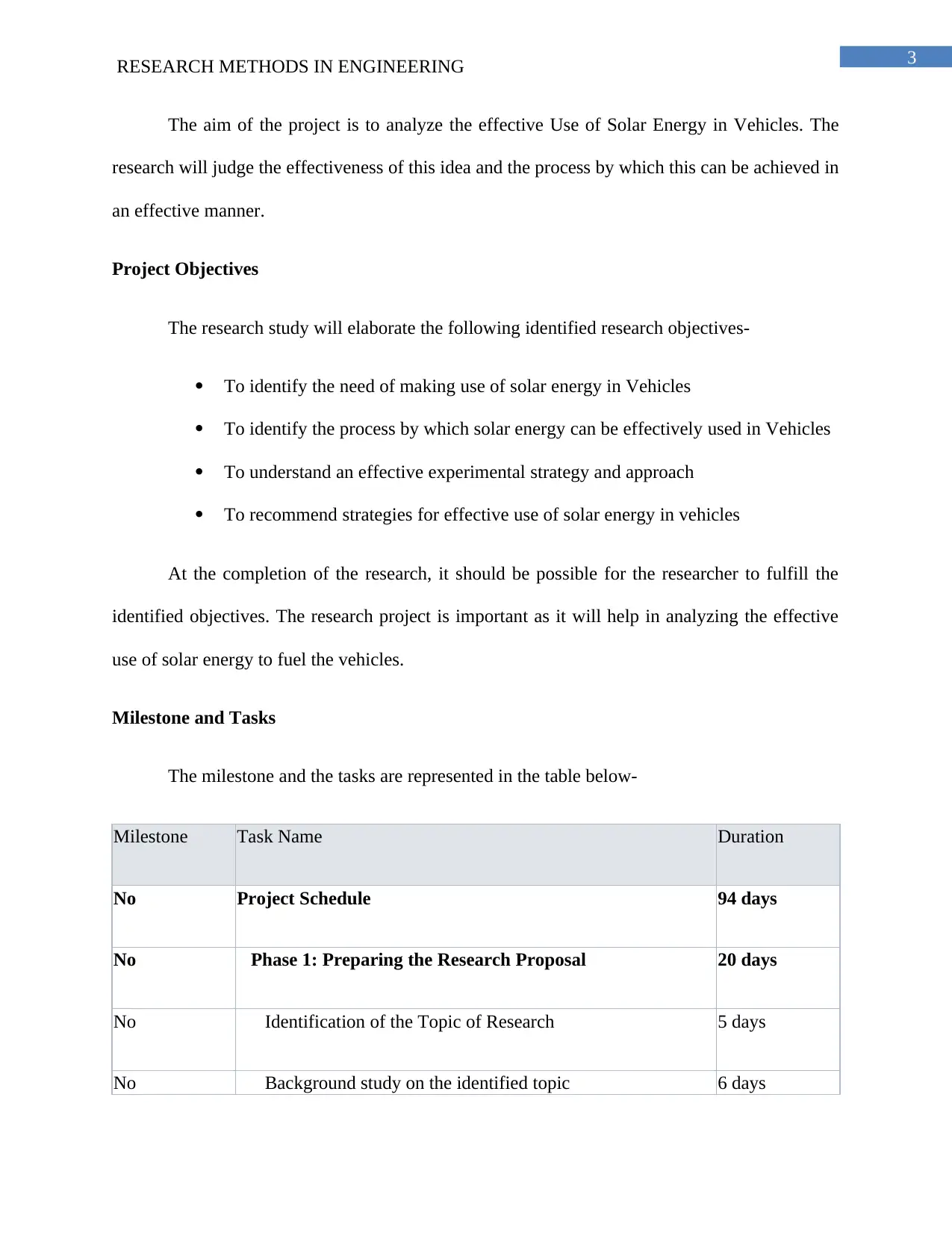
3RESEARCH METHODS IN ENGINEERING
The aim of the project is to analyze the effective Use of Solar Energy in Vehicles. The
research will judge the effectiveness of this idea and the process by which this can be achieved in
an effective manner.
Project Objectives
The research study will elaborate the following identified research objectives-
To identify the need of making use of solar energy in Vehicles
To identify the process by which solar energy can be effectively used in Vehicles
To understand an effective experimental strategy and approach
To recommend strategies for effective use of solar energy in vehicles
At the completion of the research, it should be possible for the researcher to fulfill the
identified objectives. The research project is important as it will help in analyzing the effective
use of solar energy to fuel the vehicles.
Milestone and Tasks
The milestone and the tasks are represented in the table below-
Milestone Task Name Duration
No Project Schedule 94 days
No Phase 1: Preparing the Research Proposal 20 days
No Identification of the Topic of Research 5 days
No Background study on the identified topic 6 days
The aim of the project is to analyze the effective Use of Solar Energy in Vehicles. The
research will judge the effectiveness of this idea and the process by which this can be achieved in
an effective manner.
Project Objectives
The research study will elaborate the following identified research objectives-
To identify the need of making use of solar energy in Vehicles
To identify the process by which solar energy can be effectively used in Vehicles
To understand an effective experimental strategy and approach
To recommend strategies for effective use of solar energy in vehicles
At the completion of the research, it should be possible for the researcher to fulfill the
identified objectives. The research project is important as it will help in analyzing the effective
use of solar energy to fuel the vehicles.
Milestone and Tasks
The milestone and the tasks are represented in the table below-
Milestone Task Name Duration
No Project Schedule 94 days
No Phase 1: Preparing the Research Proposal 20 days
No Identification of the Topic of Research 5 days
No Background study on the identified topic 6 days
Paraphrase This Document
Need a fresh take? Get an instant paraphrase of this document with our AI Paraphraser
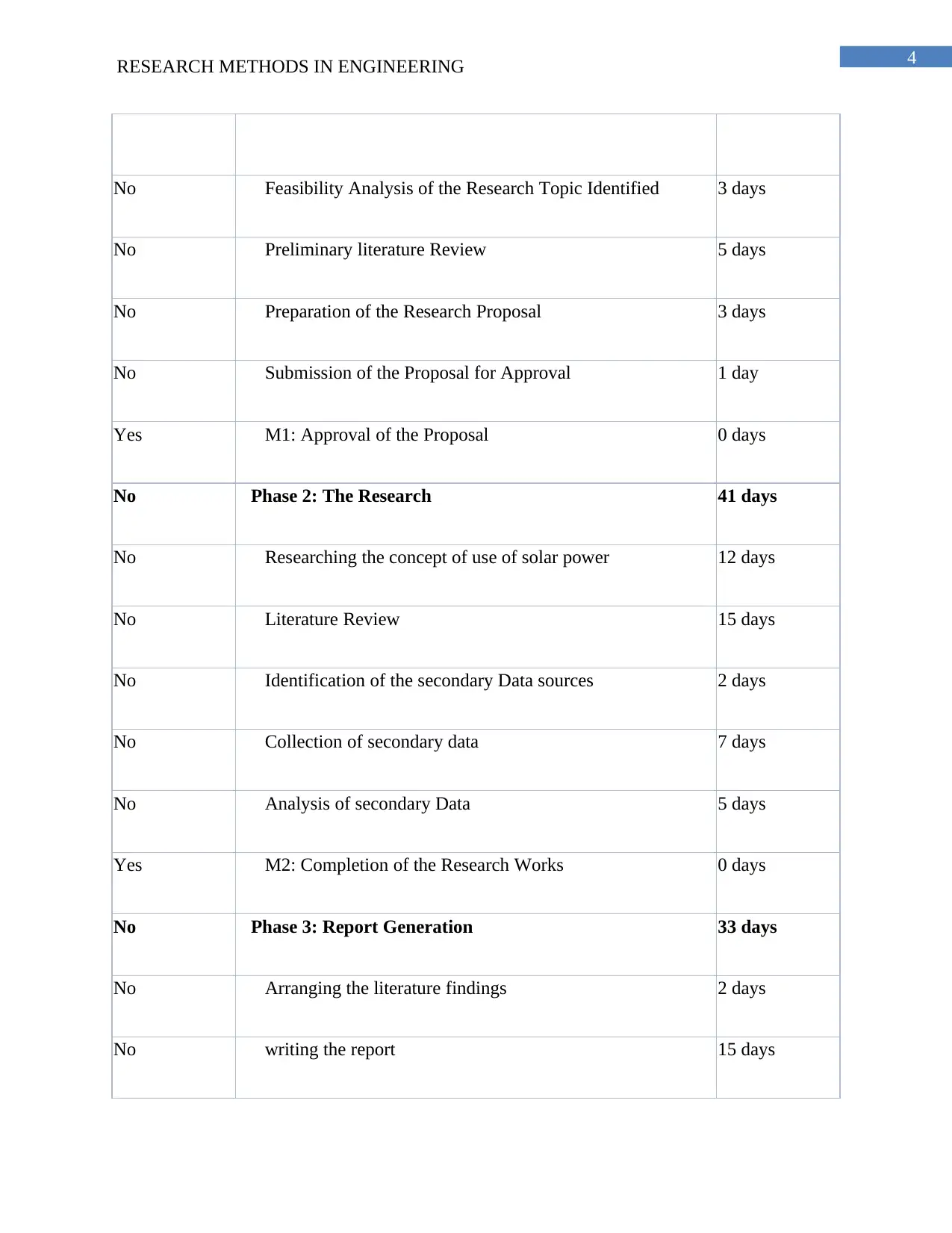
4RESEARCH METHODS IN ENGINEERING
No Feasibility Analysis of the Research Topic Identified 3 days
No Preliminary literature Review 5 days
No Preparation of the Research Proposal 3 days
No Submission of the Proposal for Approval 1 day
Yes M1: Approval of the Proposal 0 days
No Phase 2: The Research 41 days
No Researching the concept of use of solar power 12 days
No Literature Review 15 days
No Identification of the secondary Data sources 2 days
No Collection of secondary data 7 days
No Analysis of secondary Data 5 days
Yes M2: Completion of the Research Works 0 days
No Phase 3: Report Generation 33 days
No Arranging the literature findings 2 days
No writing the report 15 days
No Feasibility Analysis of the Research Topic Identified 3 days
No Preliminary literature Review 5 days
No Preparation of the Research Proposal 3 days
No Submission of the Proposal for Approval 1 day
Yes M1: Approval of the Proposal 0 days
No Phase 2: The Research 41 days
No Researching the concept of use of solar power 12 days
No Literature Review 15 days
No Identification of the secondary Data sources 2 days
No Collection of secondary data 7 days
No Analysis of secondary Data 5 days
Yes M2: Completion of the Research Works 0 days
No Phase 3: Report Generation 33 days
No Arranging the literature findings 2 days
No writing the report 15 days
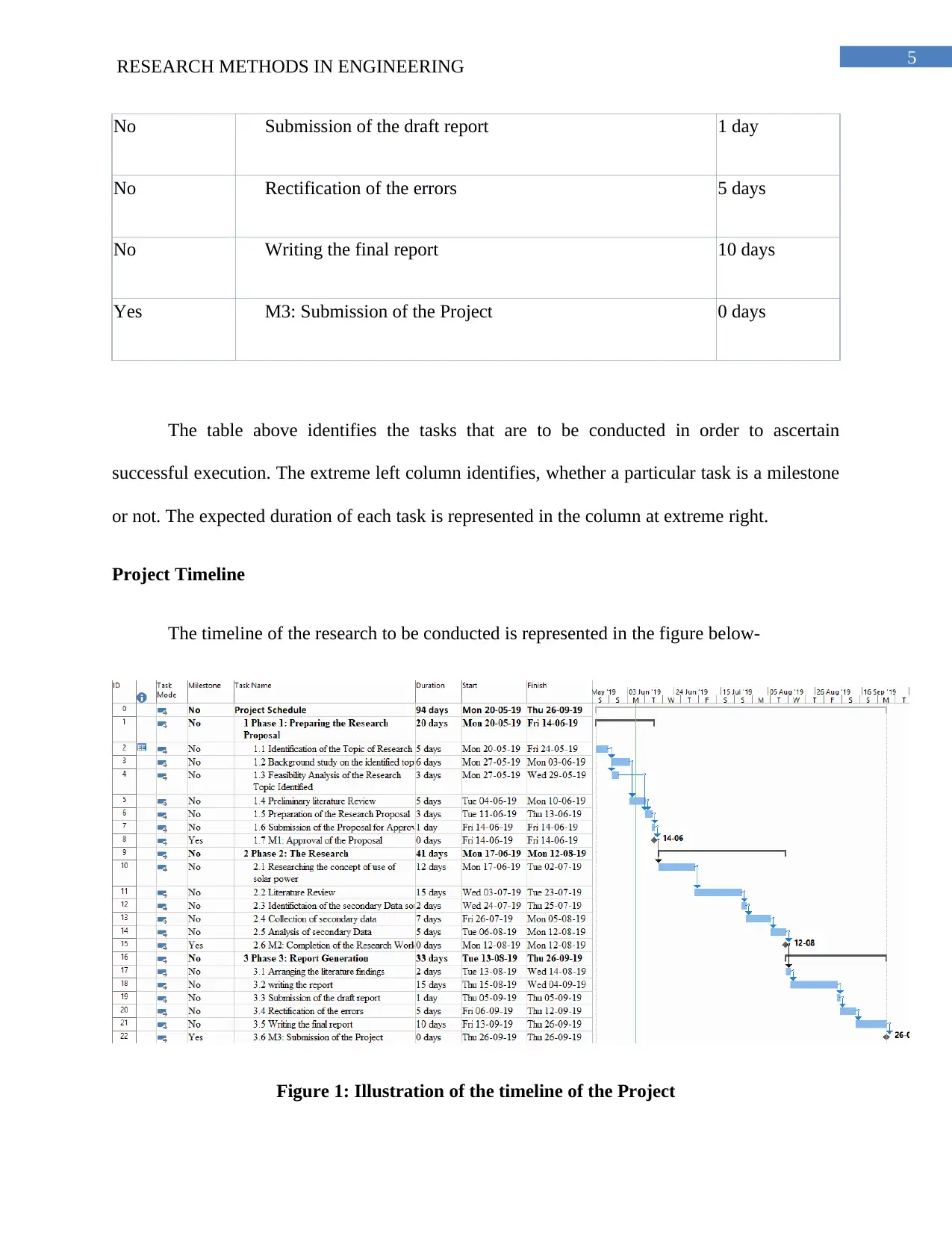
5RESEARCH METHODS IN ENGINEERING
No Submission of the draft report 1 day
No Rectification of the errors 5 days
No Writing the final report 10 days
Yes M3: Submission of the Project 0 days
The table above identifies the tasks that are to be conducted in order to ascertain
successful execution. The extreme left column identifies, whether a particular task is a milestone
or not. The expected duration of each task is represented in the column at extreme right.
Project Timeline
The timeline of the research to be conducted is represented in the figure below-
Figure 1: Illustration of the timeline of the Project
No Submission of the draft report 1 day
No Rectification of the errors 5 days
No Writing the final report 10 days
Yes M3: Submission of the Project 0 days
The table above identifies the tasks that are to be conducted in order to ascertain
successful execution. The extreme left column identifies, whether a particular task is a milestone
or not. The expected duration of each task is represented in the column at extreme right.
Project Timeline
The timeline of the research to be conducted is represented in the figure below-
Figure 1: Illustration of the timeline of the Project
⊘ This is a preview!⊘
Do you want full access?
Subscribe today to unlock all pages.

Trusted by 1+ million students worldwide
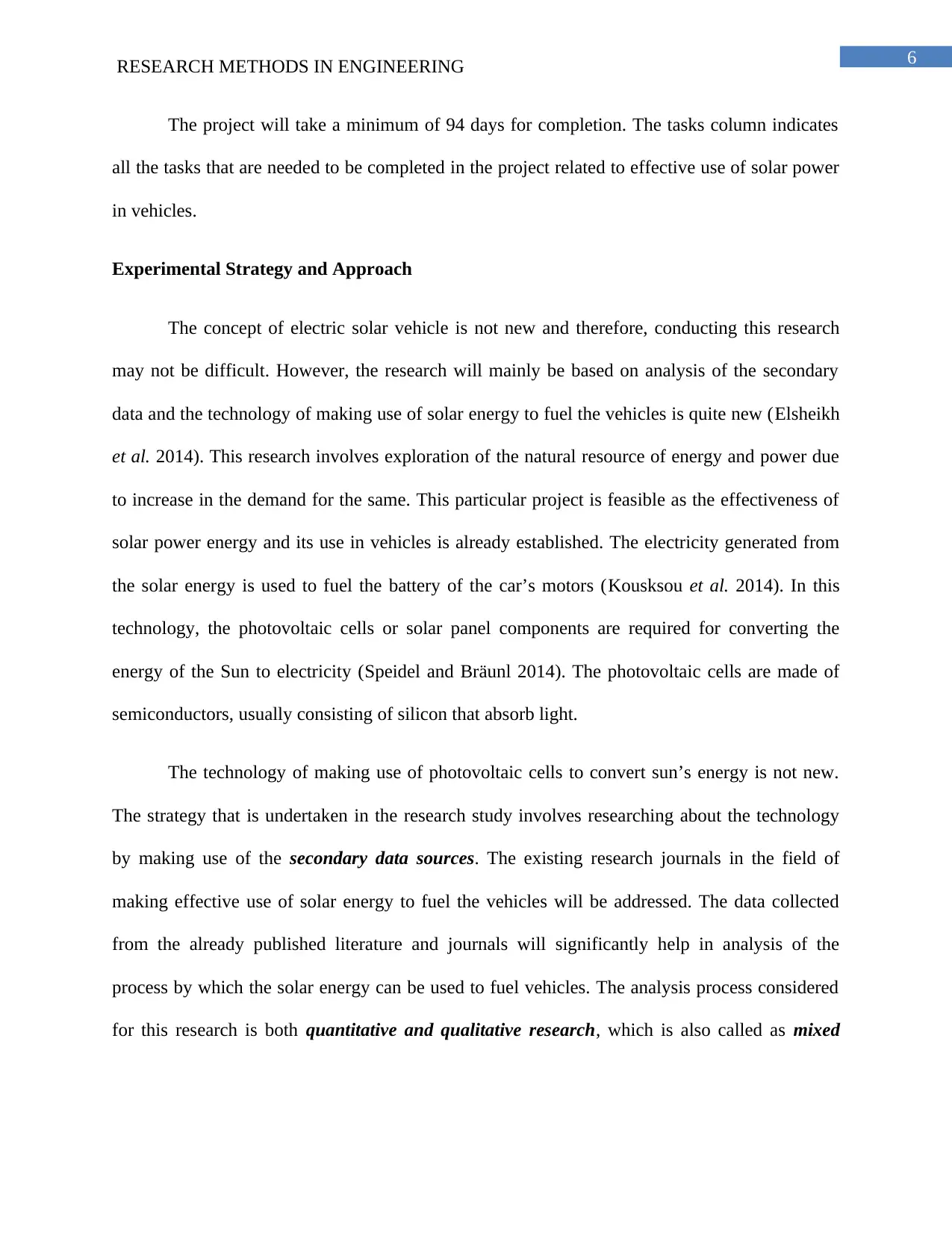
6RESEARCH METHODS IN ENGINEERING
The project will take a minimum of 94 days for completion. The tasks column indicates
all the tasks that are needed to be completed in the project related to effective use of solar power
in vehicles.
Experimental Strategy and Approach
The concept of electric solar vehicle is not new and therefore, conducting this research
may not be difficult. However, the research will mainly be based on analysis of the secondary
data and the technology of making use of solar energy to fuel the vehicles is quite new (Elsheikh
et al. 2014). This research involves exploration of the natural resource of energy and power due
to increase in the demand for the same. This particular project is feasible as the effectiveness of
solar power energy and its use in vehicles is already established. The electricity generated from
the solar energy is used to fuel the battery of the car’s motors (Kousksou et al. 2014). In this
technology, the photovoltaic cells or solar panel components are required for converting the
energy of the Sun to electricity (Speidel and Bräunl 2014). The photovoltaic cells are made of
semiconductors, usually consisting of silicon that absorb light.
The technology of making use of photovoltaic cells to convert sun’s energy is not new.
The strategy that is undertaken in the research study involves researching about the technology
by making use of the secondary data sources. The existing research journals in the field of
making effective use of solar energy to fuel the vehicles will be addressed. The data collected
from the already published literature and journals will significantly help in analysis of the
process by which the solar energy can be used to fuel vehicles. The analysis process considered
for this research is both quantitative and qualitative research, which is also called as mixed
The project will take a minimum of 94 days for completion. The tasks column indicates
all the tasks that are needed to be completed in the project related to effective use of solar power
in vehicles.
Experimental Strategy and Approach
The concept of electric solar vehicle is not new and therefore, conducting this research
may not be difficult. However, the research will mainly be based on analysis of the secondary
data and the technology of making use of solar energy to fuel the vehicles is quite new (Elsheikh
et al. 2014). This research involves exploration of the natural resource of energy and power due
to increase in the demand for the same. This particular project is feasible as the effectiveness of
solar power energy and its use in vehicles is already established. The electricity generated from
the solar energy is used to fuel the battery of the car’s motors (Kousksou et al. 2014). In this
technology, the photovoltaic cells or solar panel components are required for converting the
energy of the Sun to electricity (Speidel and Bräunl 2014). The photovoltaic cells are made of
semiconductors, usually consisting of silicon that absorb light.
The technology of making use of photovoltaic cells to convert sun’s energy is not new.
The strategy that is undertaken in the research study involves researching about the technology
by making use of the secondary data sources. The existing research journals in the field of
making effective use of solar energy to fuel the vehicles will be addressed. The data collected
from the already published literature and journals will significantly help in analysis of the
process by which the solar energy can be used to fuel vehicles. The analysis process considered
for this research is both quantitative and qualitative research, which is also called as mixed
Paraphrase This Document
Need a fresh take? Get an instant paraphrase of this document with our AI Paraphraser
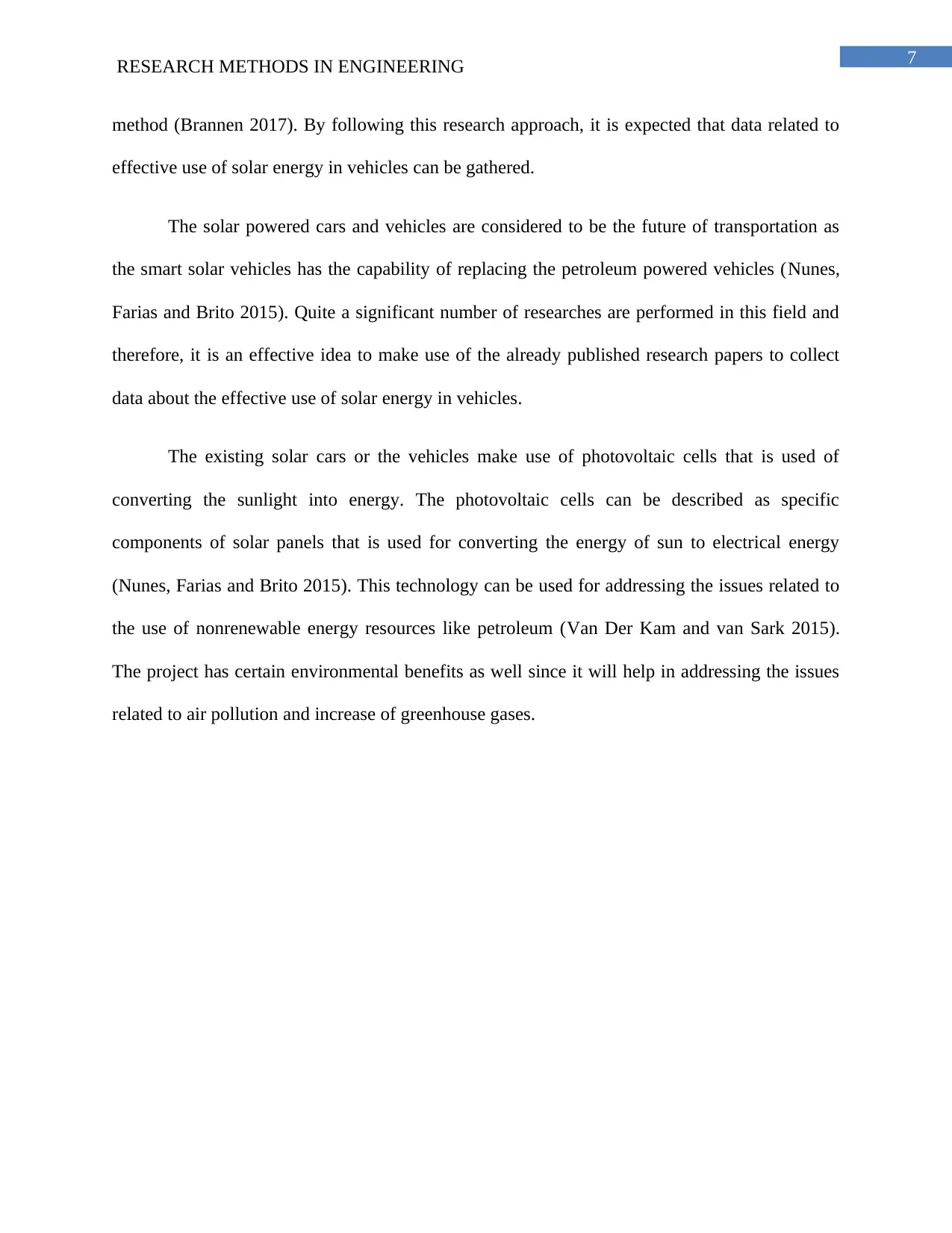
7RESEARCH METHODS IN ENGINEERING
method (Brannen 2017). By following this research approach, it is expected that data related to
effective use of solar energy in vehicles can be gathered.
The solar powered cars and vehicles are considered to be the future of transportation as
the smart solar vehicles has the capability of replacing the petroleum powered vehicles (Nunes,
Farias and Brito 2015). Quite a significant number of researches are performed in this field and
therefore, it is an effective idea to make use of the already published research papers to collect
data about the effective use of solar energy in vehicles.
The existing solar cars or the vehicles make use of photovoltaic cells that is used of
converting the sunlight into energy. The photovoltaic cells can be described as specific
components of solar panels that is used for converting the energy of sun to electrical energy
(Nunes, Farias and Brito 2015). This technology can be used for addressing the issues related to
the use of nonrenewable energy resources like petroleum (Van Der Kam and van Sark 2015).
The project has certain environmental benefits as well since it will help in addressing the issues
related to air pollution and increase of greenhouse gases.
method (Brannen 2017). By following this research approach, it is expected that data related to
effective use of solar energy in vehicles can be gathered.
The solar powered cars and vehicles are considered to be the future of transportation as
the smart solar vehicles has the capability of replacing the petroleum powered vehicles (Nunes,
Farias and Brito 2015). Quite a significant number of researches are performed in this field and
therefore, it is an effective idea to make use of the already published research papers to collect
data about the effective use of solar energy in vehicles.
The existing solar cars or the vehicles make use of photovoltaic cells that is used of
converting the sunlight into energy. The photovoltaic cells can be described as specific
components of solar panels that is used for converting the energy of sun to electrical energy
(Nunes, Farias and Brito 2015). This technology can be used for addressing the issues related to
the use of nonrenewable energy resources like petroleum (Van Der Kam and van Sark 2015).
The project has certain environmental benefits as well since it will help in addressing the issues
related to air pollution and increase of greenhouse gases.
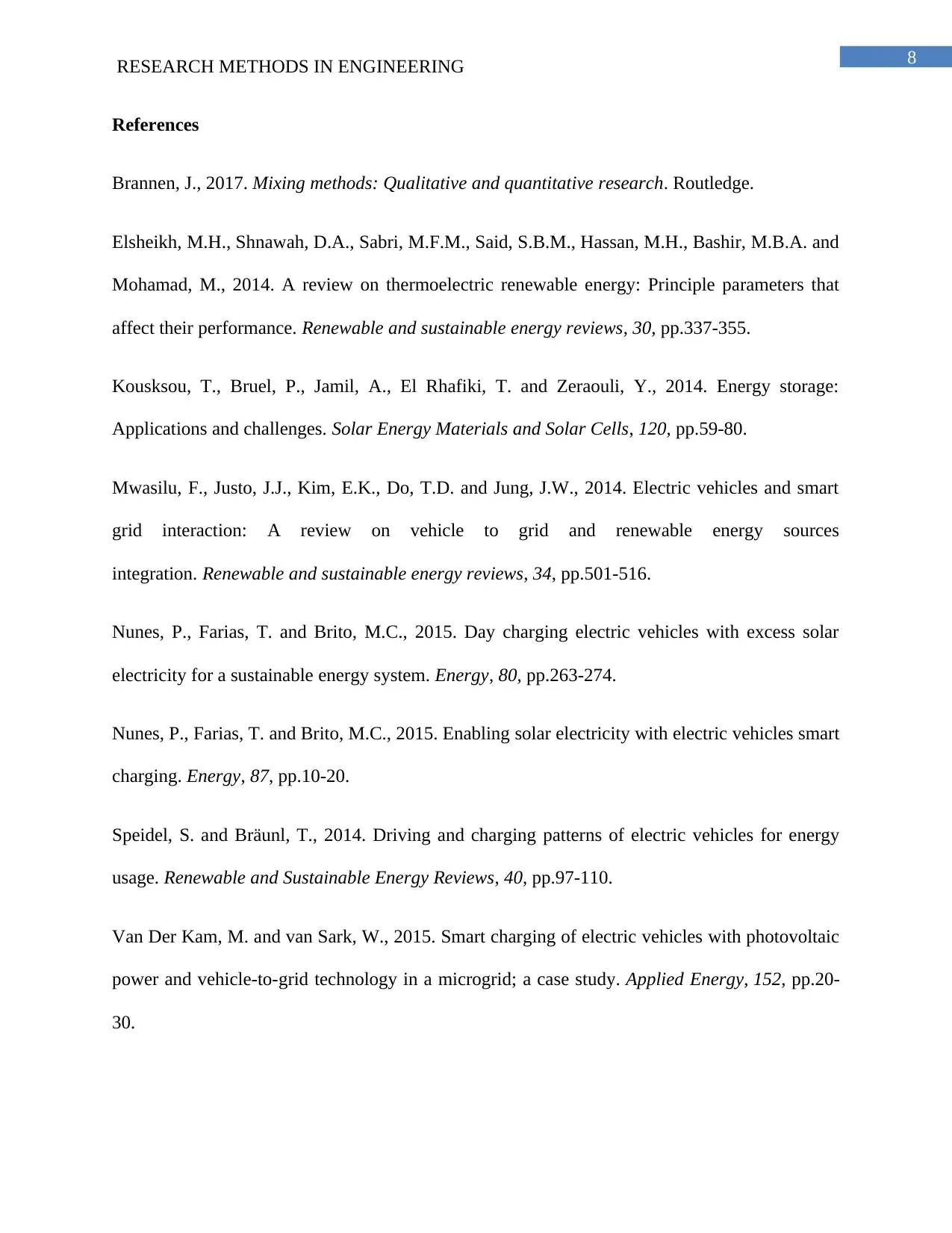
8RESEARCH METHODS IN ENGINEERING
References
Brannen, J., 2017. Mixing methods: Qualitative and quantitative research. Routledge.
Elsheikh, M.H., Shnawah, D.A., Sabri, M.F.M., Said, S.B.M., Hassan, M.H., Bashir, M.B.A. and
Mohamad, M., 2014. A review on thermoelectric renewable energy: Principle parameters that
affect their performance. Renewable and sustainable energy reviews, 30, pp.337-355.
Kousksou, T., Bruel, P., Jamil, A., El Rhafiki, T. and Zeraouli, Y., 2014. Energy storage:
Applications and challenges. Solar Energy Materials and Solar Cells, 120, pp.59-80.
Mwasilu, F., Justo, J.J., Kim, E.K., Do, T.D. and Jung, J.W., 2014. Electric vehicles and smart
grid interaction: A review on vehicle to grid and renewable energy sources
integration. Renewable and sustainable energy reviews, 34, pp.501-516.
Nunes, P., Farias, T. and Brito, M.C., 2015. Day charging electric vehicles with excess solar
electricity for a sustainable energy system. Energy, 80, pp.263-274.
Nunes, P., Farias, T. and Brito, M.C., 2015. Enabling solar electricity with electric vehicles smart
charging. Energy, 87, pp.10-20.
Speidel, S. and Bräunl, T., 2014. Driving and charging patterns of electric vehicles for energy
usage. Renewable and Sustainable Energy Reviews, 40, pp.97-110.
Van Der Kam, M. and van Sark, W., 2015. Smart charging of electric vehicles with photovoltaic
power and vehicle-to-grid technology in a microgrid; a case study. Applied Energy, 152, pp.20-
30.
References
Brannen, J., 2017. Mixing methods: Qualitative and quantitative research. Routledge.
Elsheikh, M.H., Shnawah, D.A., Sabri, M.F.M., Said, S.B.M., Hassan, M.H., Bashir, M.B.A. and
Mohamad, M., 2014. A review on thermoelectric renewable energy: Principle parameters that
affect their performance. Renewable and sustainable energy reviews, 30, pp.337-355.
Kousksou, T., Bruel, P., Jamil, A., El Rhafiki, T. and Zeraouli, Y., 2014. Energy storage:
Applications and challenges. Solar Energy Materials and Solar Cells, 120, pp.59-80.
Mwasilu, F., Justo, J.J., Kim, E.K., Do, T.D. and Jung, J.W., 2014. Electric vehicles and smart
grid interaction: A review on vehicle to grid and renewable energy sources
integration. Renewable and sustainable energy reviews, 34, pp.501-516.
Nunes, P., Farias, T. and Brito, M.C., 2015. Day charging electric vehicles with excess solar
electricity for a sustainable energy system. Energy, 80, pp.263-274.
Nunes, P., Farias, T. and Brito, M.C., 2015. Enabling solar electricity with electric vehicles smart
charging. Energy, 87, pp.10-20.
Speidel, S. and Bräunl, T., 2014. Driving and charging patterns of electric vehicles for energy
usage. Renewable and Sustainable Energy Reviews, 40, pp.97-110.
Van Der Kam, M. and van Sark, W., 2015. Smart charging of electric vehicles with photovoltaic
power and vehicle-to-grid technology in a microgrid; a case study. Applied Energy, 152, pp.20-
30.
⊘ This is a preview!⊘
Do you want full access?
Subscribe today to unlock all pages.

Trusted by 1+ million students worldwide
1 out of 9
Related Documents
Your All-in-One AI-Powered Toolkit for Academic Success.
+13062052269
info@desklib.com
Available 24*7 on WhatsApp / Email
![[object Object]](/_next/static/media/star-bottom.7253800d.svg)
Unlock your academic potential
Copyright © 2020–2025 A2Z Services. All Rights Reserved. Developed and managed by ZUCOL.





